What Did Ancient Architects and Builders Use in the Construction of Classical Cathedrals Art
Of all the great architectural movements that swept across Europe since antiquity, Romanesque Compages was the first to emerge after the autumn of the Romans. When the Western Roman Empire fell in the fifth century, at that place was a huge decline in significant building projects for hundreds of years. But at the finish of this period now known as the Night Ages, a new fashion of architecture emerged. Borrowing heavily from older forms of Roman Buildings, Romanesque Architecture emerged to be the ascendant building style in Western Europe, long before the inflow of the Gothic Age.
Definition of Romanesque Architecture
Romanesque compages and fine art was a form of pattern that borrowed extensively from Aboriginal Roman art and architecture and was used throughout Europe from 500-1200 CE.

Photo past PROPOLI87 from Wikimedia Eatables
Timeline of Romanesque Architecture
Romanesque architecture was the dominant building style in Europe from roughly the point afterward the autumn of the Roman Empire in the fifth century to the beginning of the Gothic Era in the 13th century.
Developing from religious structures such every bit churches, monasteries, and abbeys, the Romanesque Style eventually spread into almost all types of buildings. The Dark Ages and Early Middle ages were the major periods that heavily utilized this style.
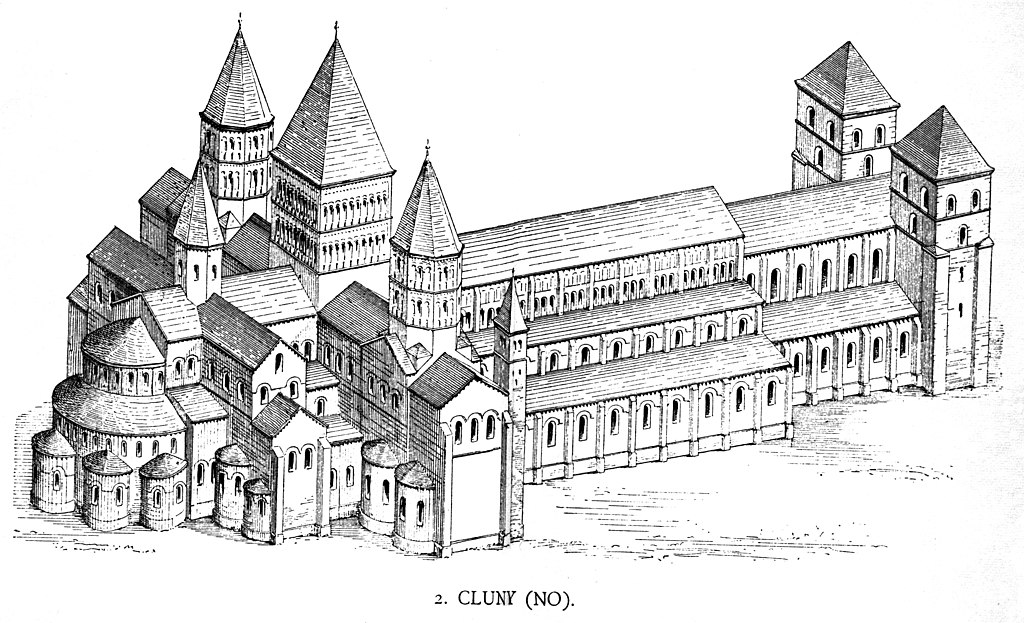
Paradigm from the US Public Domain
Romanesque Architecture Characteristics
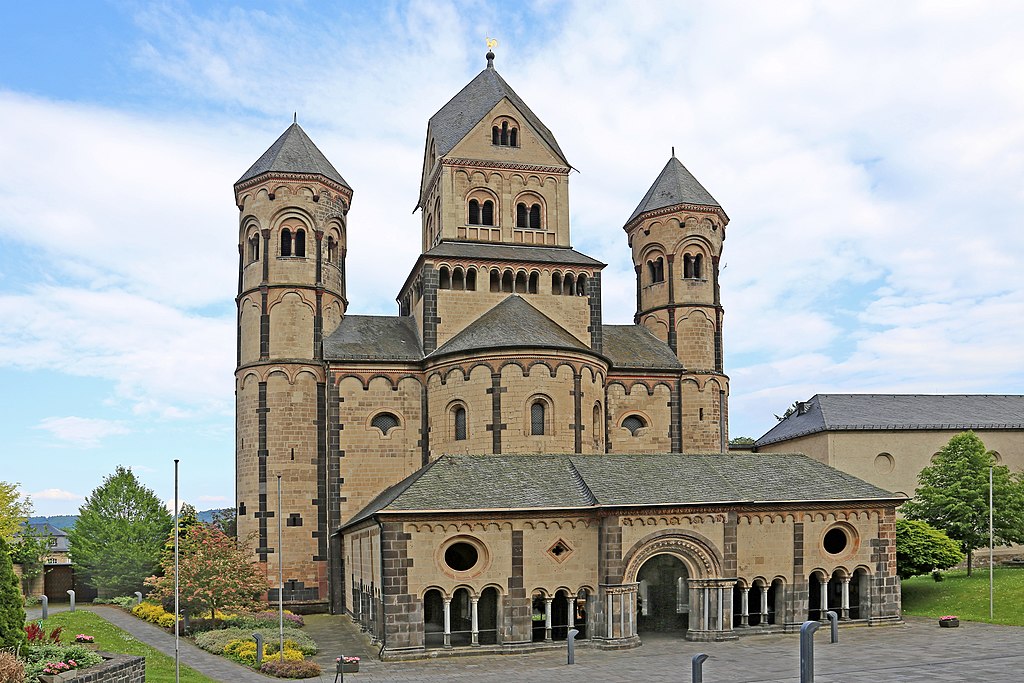
Rounded Arches or "Roman Arches"
Photograph by W. Bulach from Wikimedia Eatables
Past far, the most dominant characteristic in Romanesque Architecture is the round arch. Besides referred to equally the Roman Curvation, the round arch predates the pointed Gothic arch. Information technology had already been used in compages for hundreds of years at the kickoff of the middle ages, most notably in Ancient Roman Architecture. In the photograph above you tin can encounter the entire due west facade of Maria Laach Abbey in Germany is decorated with different forms of the same round arch,

Thick Walls with Small Windows
Photo by Nuno Cardoso from flickr
Overall Romanesque Architecture is full of stout, bulky, heavy, and sturdy-looking buildings. Walls had to exist thick with minor windows, to take the full weight of the roof to a higher place. The unabridged exterior of Pisa Cathedral shows how even the almost awe-inspiring and impressive Romanesque buildings were built this way. Later on in architectural history, Flying Buttress allowed architects to build taller buildings with walls full of huge windows – which became the foundation for the Gothic Style.
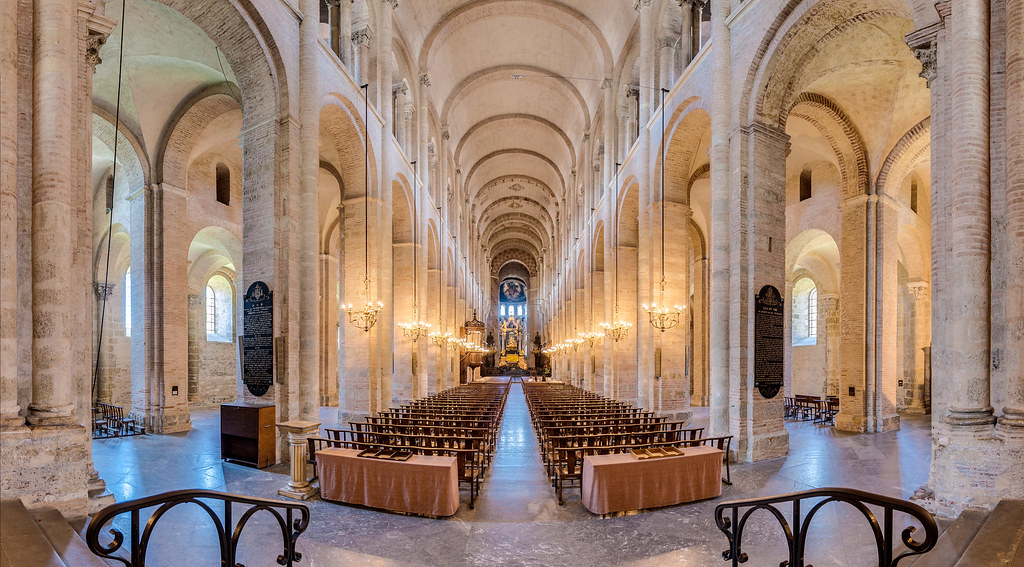
Butt Vaults
Photo byBenh Lieu Song from flickr
Earlier in the Romanesque age, the Naves of most churches were capped with wooden roofs. This was a format that dated all the way back to the aboriginal Roman Basilica. Eventually, the cathedrals of Europe started to get more sophisticated, amalgam archways over their naves. Builders would essentially compress multiple stone arches together, to create a barrel vault. Rock barrel vaults also made churches sturdier and helped out with fire protection likewise, since at that place were no exposed wooden timbers in the roof to burn. The barrel vault within the Basilica of Saint-Sernin was ane of the largest ever constructed in the Romanesque Age.
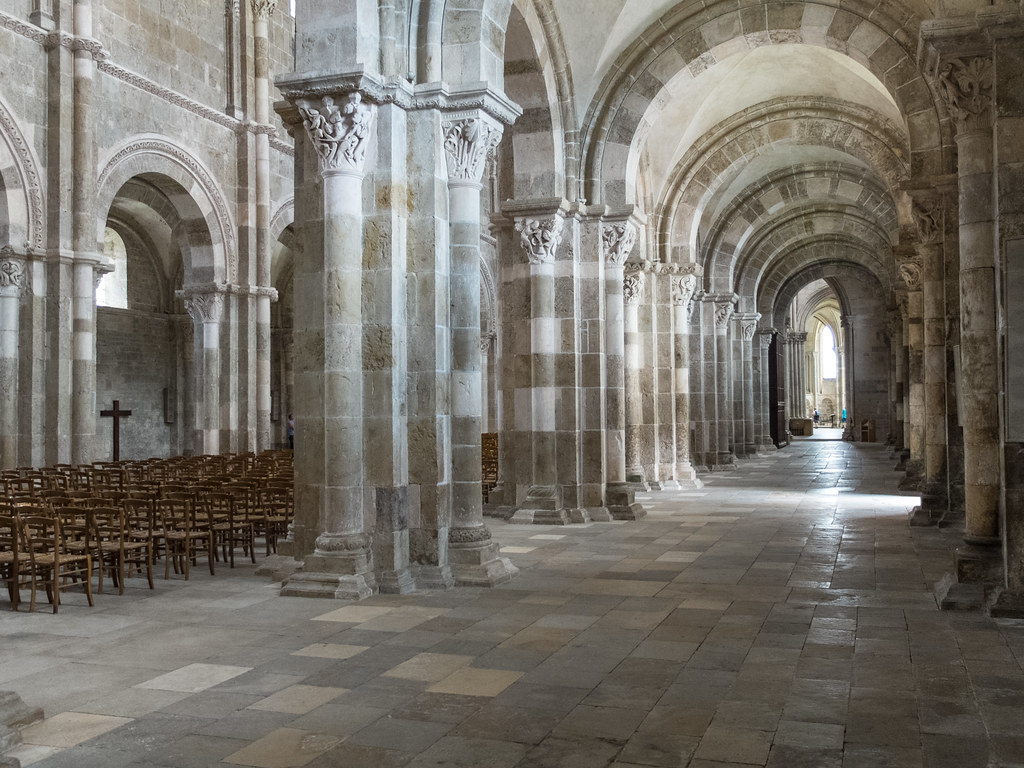
Lack of Ornamentation and Detail
Photo by Anna & Michal from flickr
Many Romanesque Churches share a distinct lack of decoration when compared to churches built in the Gothic Age. Although there are a few exceptions, virtually Romanesque buildings are stark and blank, and they only have intricate stonework in a few isolated spots. This lack of detail is especially apparent early on in the Romanesque age, before the year one thousand CE. Vézelay Abbey in France was built generally in the early 1100s, but hither you can see some sculptural elements start to appear, particularly in the column capitals.
Romanesque vs. Gothic
Romanesque architecture came earlier Gothic architecture. The Romanesque period lasted from the 6th-12th century, while the Gothic Period lasted from the xiiith-16th century.
-

Romanesque -
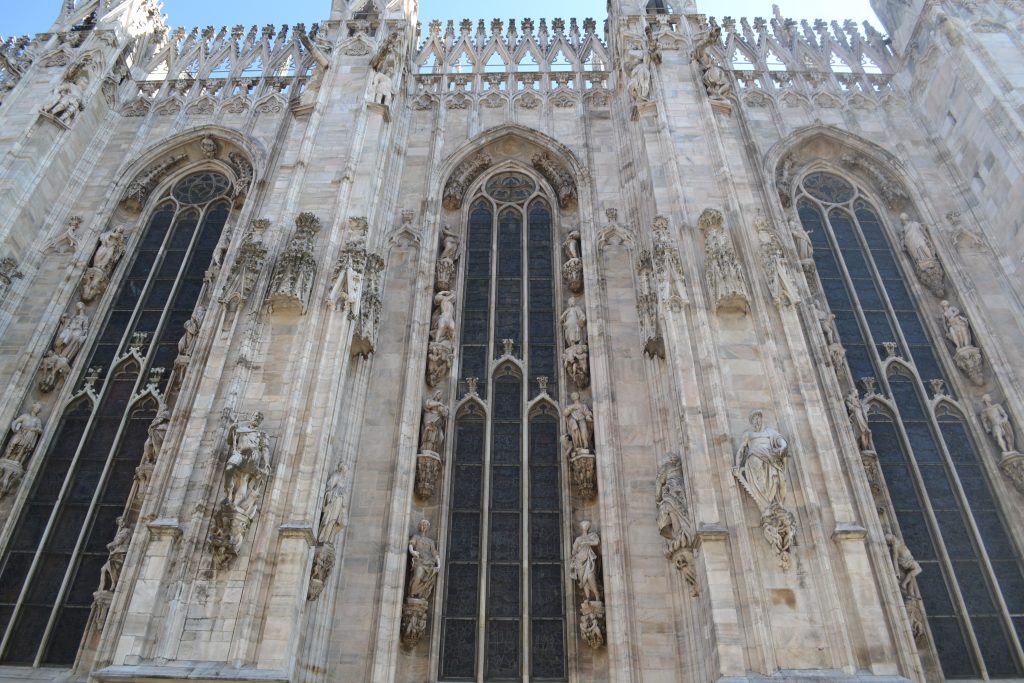
Gothic
- (left) Rounded arches at Speyer Cathedral in Germany
- (right) Pointed arches at Milan Cathedral in Italia
- Correct Photo by © José Luiz Bernardes Ribeiro / CC By-SA four.0
At that place are many differences between the two styles. A lot of these differences have to do with European history during the eye ages. Technology was advancing, and people were able to build larger more graceful buildings during the Gothic Flow.
New edifice techniques similar the pointed arch and the flying buttress allowed architects to build taller and larger churches. The buttresses allowed the weight of the roof to be spread outward with the help of the pointed arches.
-
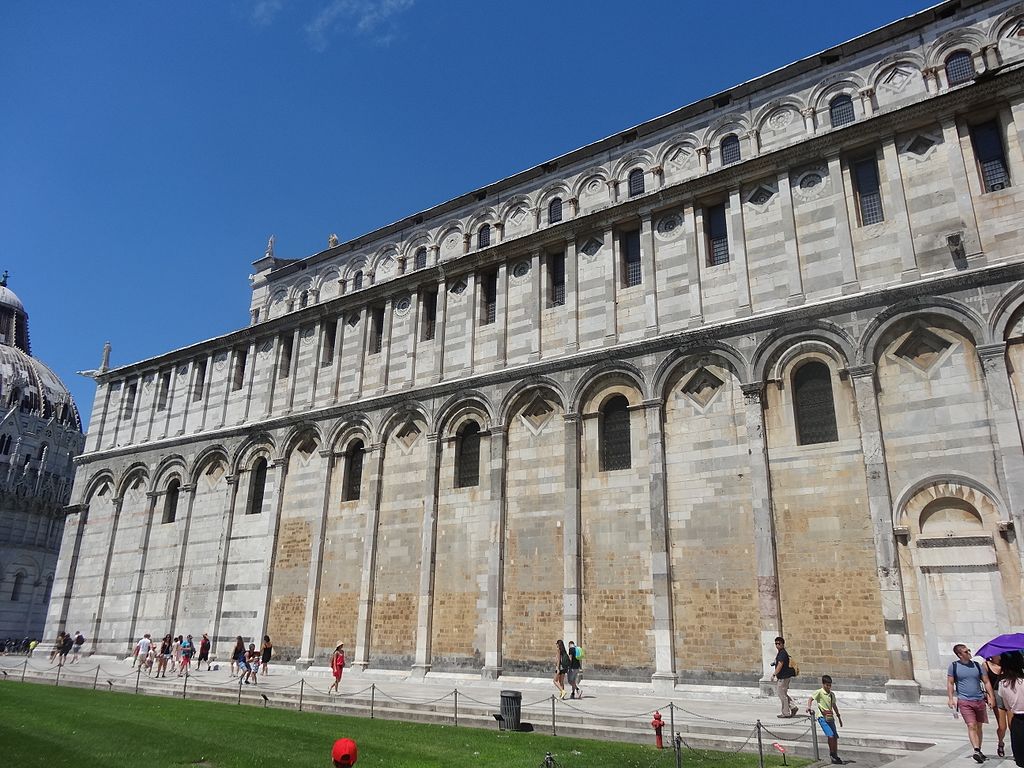
Romanesque -
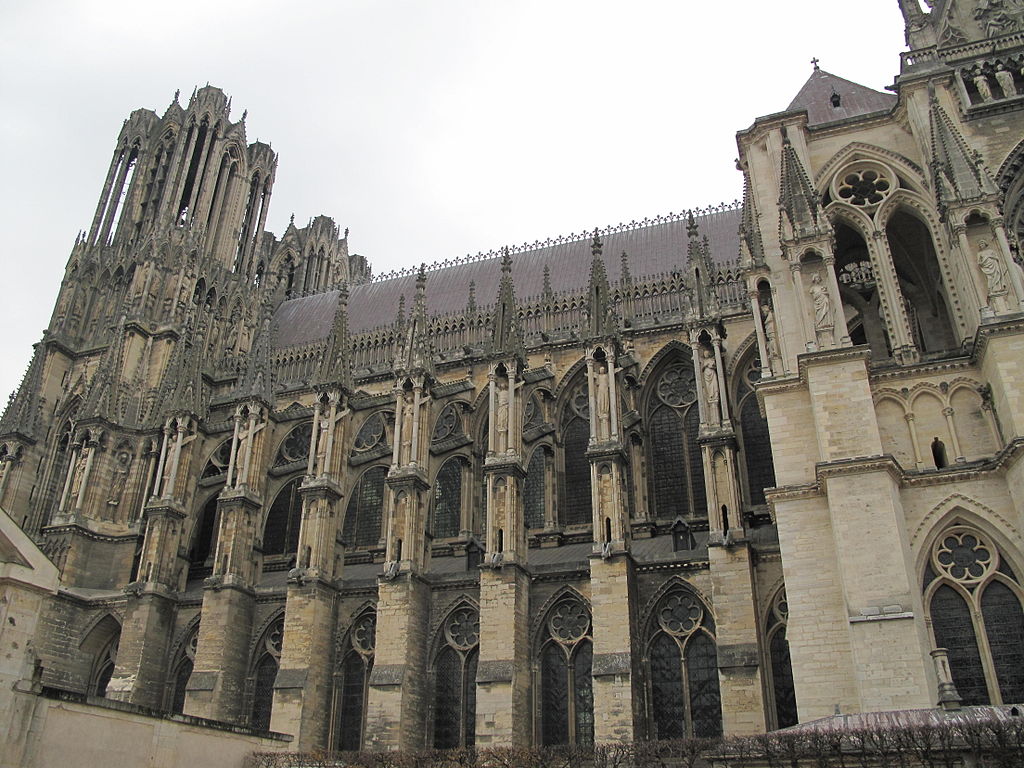
Gothic
- (left) Side of Pisa Cathedral, with flat walls that have small windows with round arches
- (correct) Side of Reims Cathedral, with flight buttresses which allow for huge windows with gothic arches
- Left Photo past Jordiferrer from Wikimedia Eatables
So now, instead of having thick stone walls with tiny windows to support your roof, like in a Romanesque edifice, you could use the buttresses to take the weight of the roof. This allowed architects to use these beautiful massive stained glass windows that would allow incredible amounts of light into the interior infinite.
-

Romanesque -
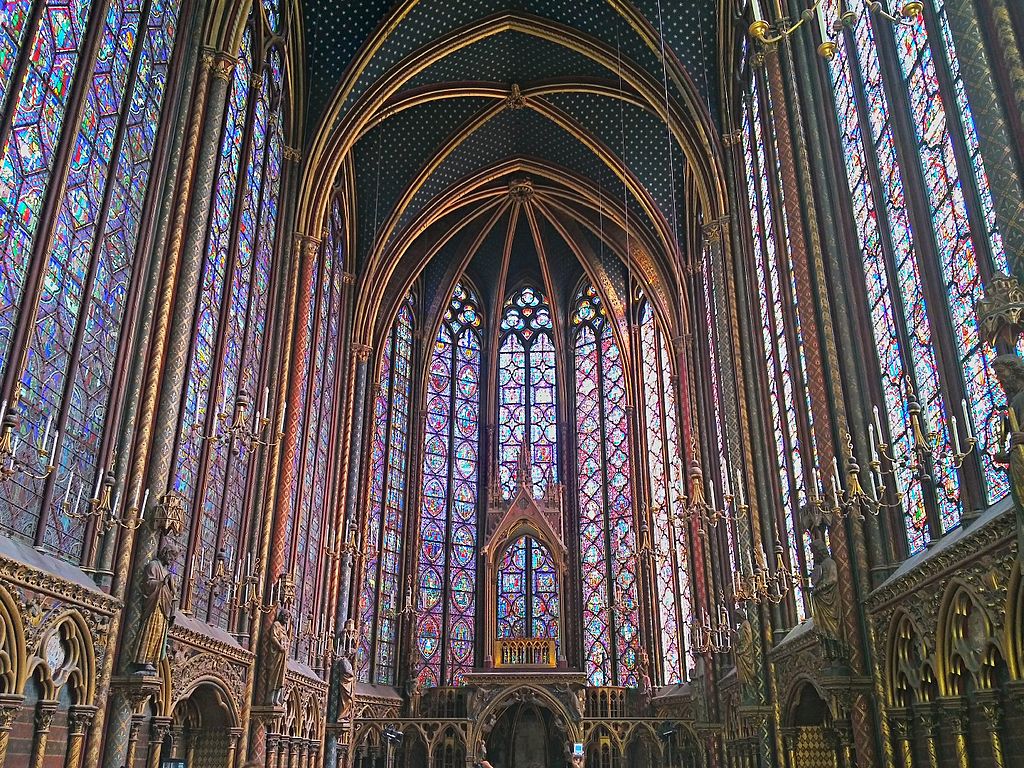
Gothic
- (left) The interior of Vézelay Abbey in Vézelay, French republic. Notice the vaulted ceiling, rounded arches, heavy windows with a lack of natural light, and the lack of excessive particular and artwork.
- (right) The interior of Sainte Chappelle in Paris, French republic. Notice the ribbed ceiling, the pointed arches, and the massive stained glass windows filled with intricate artwork.
- Left Photograph by Jörb Bittner Unna from Wikimedia Commons
- Right Photo past Artmch from Wikimedia Commons
Romanesque compages also does not include the copious amount of detail that you detect in Gothic architecture. Below y'all volition encounter some uncomplicated geometric stonework in a Romanesque church, compared to the elaborate carvings in a Gothic building.
-
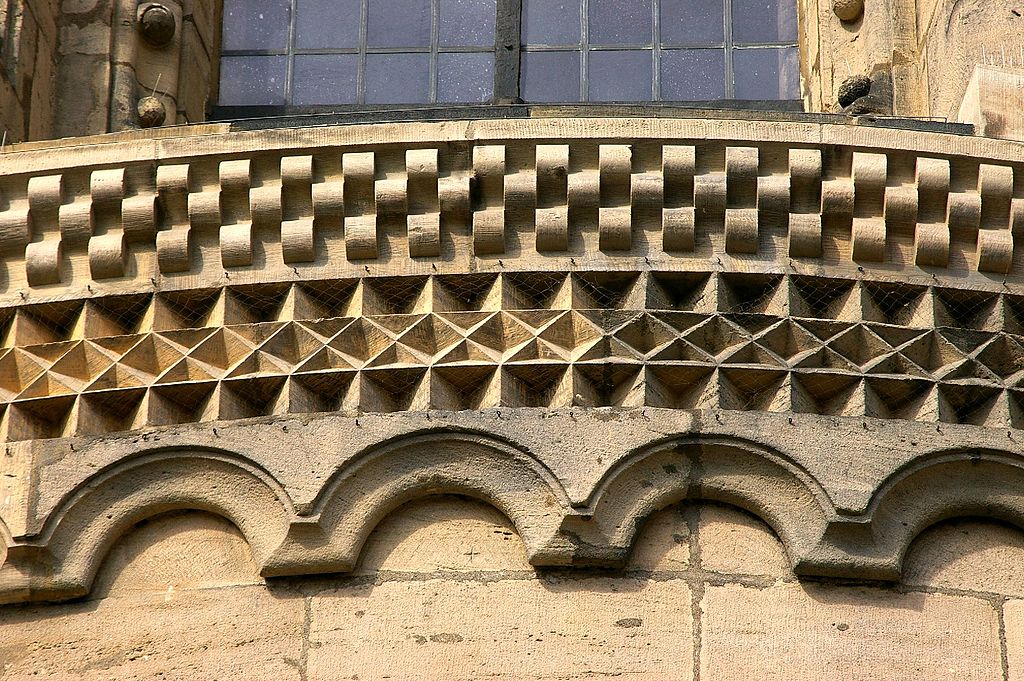
Romanesque -
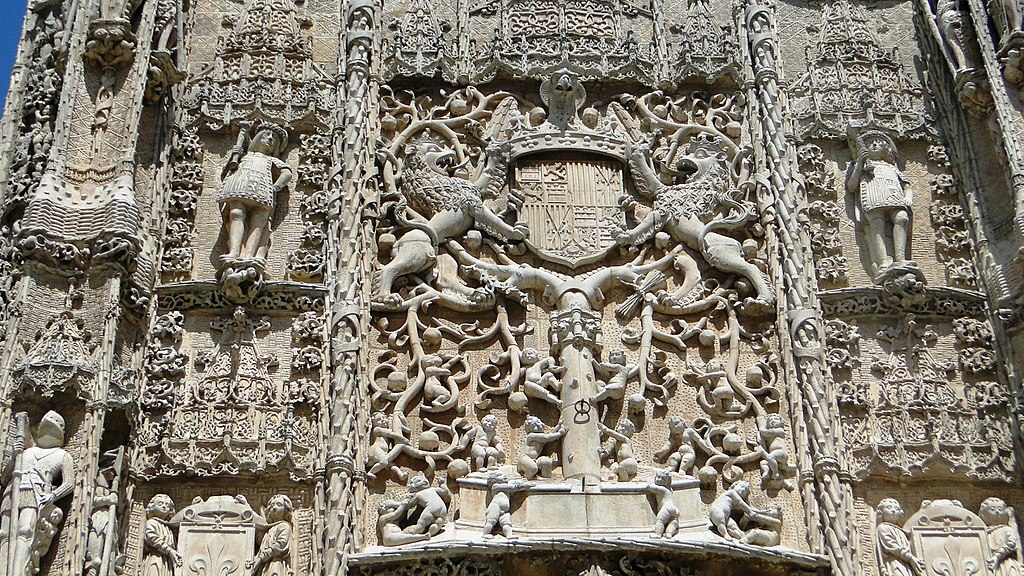
Gothic
- (left) Romanesque detailing at Bamberg Cathedral in Bramber, Germany
- (right) Belatedly Gothic detailing at the Colegio de San Gregoria in Valladolid, Spain
- Left Photo past Reinhard Kirchner from Wikimedia Commons
- Right Photo past Rafael Tello from Wikimedia Eatables
Again, the discrepancies in the detailing had a lot to do with European history. Religious authorities in the eye ages were oft opposed to excessive fine art and details, as they were idea to distract from the services of the church. But eventually, these practices were slowly abandoned, and art was fabricated more openly, so long as it told the bulletin of the church and the bible.
It'south scaled back, only in Romanesque compages, you can encounter fine details and carved stonework. Y'all will notice stories from the bible, depicted mostly around column capitals and within the Tympanum, the main entrance higher up the entrance to a church. Gothic architecture took this a step further and showed fifty-fifty more intricate depictions of various religious motifs.
-

Romanesque -
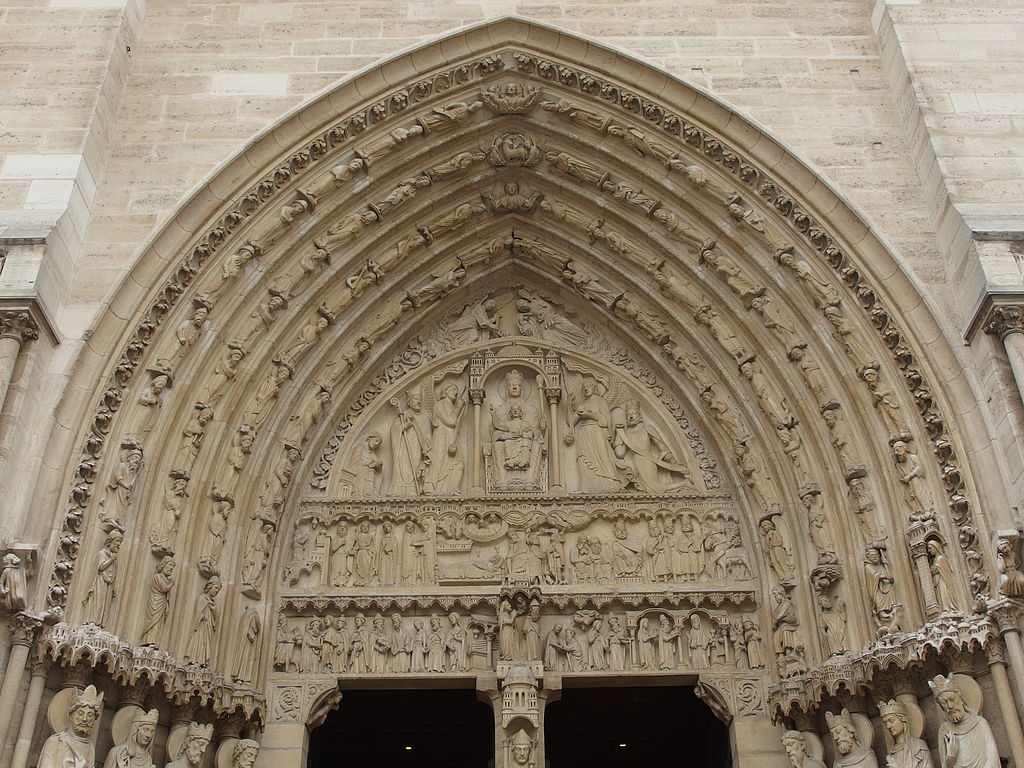
Gothic
- (left) Tympanum at Vézelay Abbey in Vézelay, French republic
- (correct) Tympanum at Notre Dame in Paris, France
- Both carvings depict the scene of the last judgment, however, the Gothic version is much more intricate and detailed, with meaning improvement in the realism of the sculpture. The carvings also leave the expanse of the Tympanum and pour down and effectually the doorway and into the residue of the building.
- Left Photo by Gerd Eichmann from Wikimedia Commons
- Right Photograph by Guilhem Vellut from Wikimedia Eatables
Interested in Romanesque Architecture? Check out some of our other related articles!
What are the Best Romanesque Buildings?
Below is a listing of buildings that are frequently regarded as the best examples of Romanesque architecture. These buildings show all of the cardinal features of the Romanesque style.
Rather than only focusing on churches, this list will also incorporate secular buildings as well to give a cohesive look at Romanesque Architecture. This list will focus on size, innovation, and overall beauty to determine what are the all-time Romanesque buildings that tin can nonetheless be found in Europe today.
one. Pisa Cathedral – Pisa, Tuscany, Italia
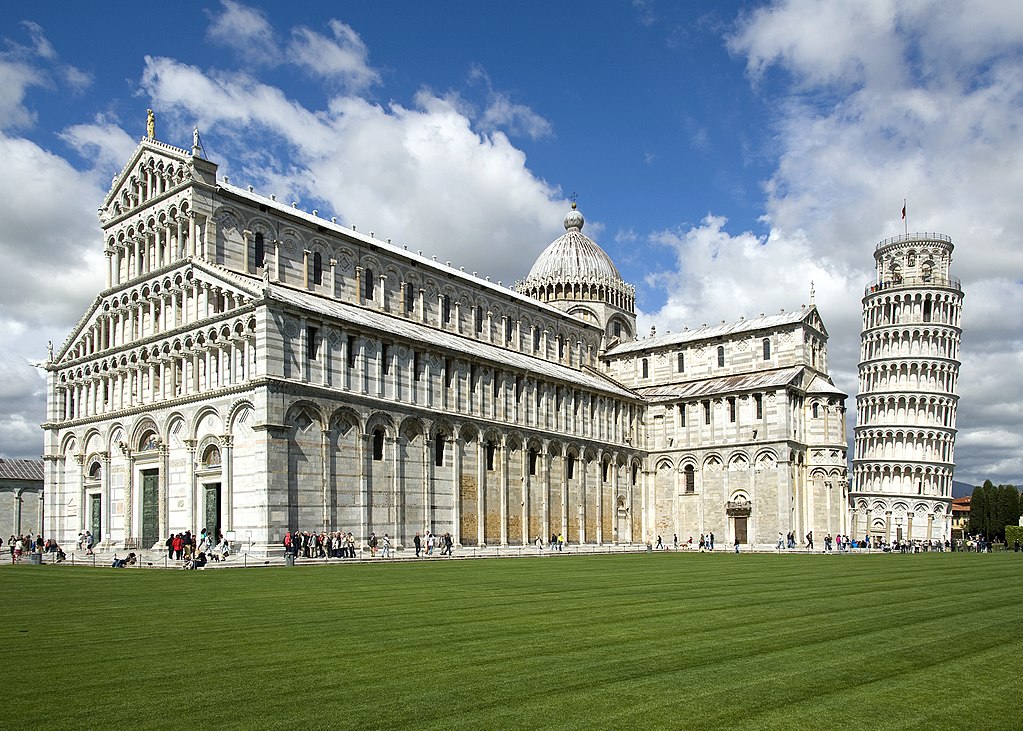
Pisa Cathedral may be known for its leaning belfry, but it's also one of the greatest examples of Romanesque Architecture on earth. The cathedral, baptistery, and bong tower are all built with white marble. The front end elevation shows many of the standard elements of Romanesque compages, with dozens of circular arches surrounded by geometric stonework. Although the church'south exterior has a lot of windows, all of them are small-scale and they don't provide a lot of natural light. The walls of Pisa Cathedral are the only thing supporting the roof to a higher place, and that's why they had to be built thick and sturdy, with merely modest openings for windows.

The interior of Pisa Cathedral shows a blend of a few dissimilar styles. The arches and columns you see are all romanesque, and they date from the original construction of the cathedral which took place from 1063-1092. But the golden-detailing you see in the coffered ceiling was added afterwards on, during the 17th century. Today the leaning tower of Pisa and Pisa Cathedral bring in millions of visitors every year, and they are listed as UNESCO Earth Heritage Sites.
ii. Cathedral of Monreale – Monreale, Sicily, Italy
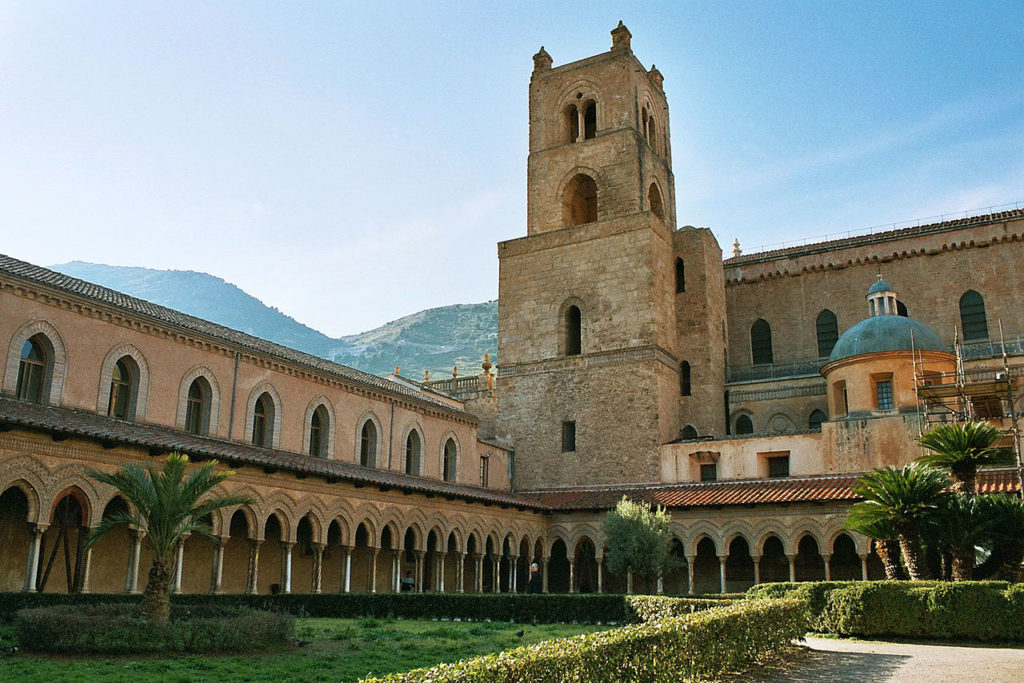
Much like other churches in Sicily, the Cathedral of Monreale was constructed past the Normans. Its located just exterior of the Sicilian capital Palermo and is regarded equally one of the greatest churches on the island. Construction began in 1172 and most of the compages is Norman, although diverse additions were added in other styles. The church building is famous for its Byzantine Mosaics. The church building is office of a big grouping of UNESCO Listed sites found throughout the area around Palermo.

The church is famous for its Byzantine Mosaics. These mosaics cost the Normans vast amounts of wealth to build. Not merely were the tiles fabricated with fragments of real gold, but the mosaics themselves were also painstakingly assembled by Byzantine Craftsmen, some of whom traveled all the way from the Eastern Mediterranean lands of the Byzantine Empire.
3. San Miniato al Monte – Florenceast, Tuscany, Italian republic
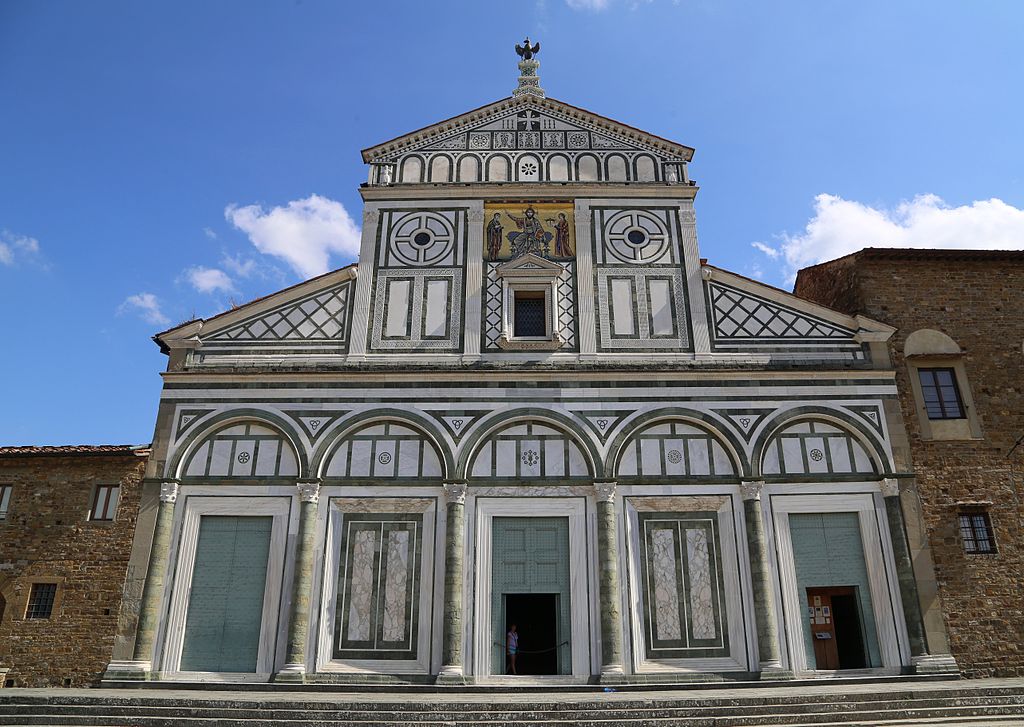
Merely similar Pisa Cathedral, San Miniato al Monte is an incredible Romanesque Church, located in the Italian Region of Tuscany. Work started in the church back in 1013, and today information technology looks largely the same fashion it did back in the 11th century. The exterior is richly decorated with white and green marble, in a color scheme similar to that of Florence Cathedral, although the cathedral was built centuries later.
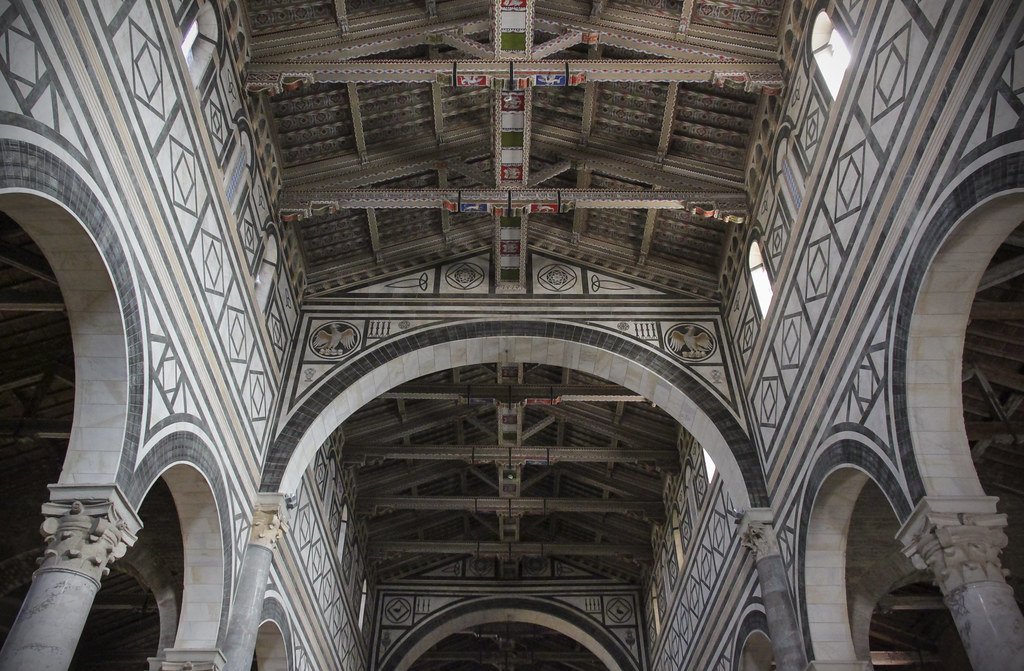
The interior of the church features more intricate stonework, with colored marble to lucifer the exterior. The church as well features a wooden roof, which was the main fabric used for the roofs of early Romanesque buildings. The beams and joists are all richly decorated with painted geometric designs. Although San Miniato al Monte is one of the smaller churches in Florence, it's still an incredible piece of work of Romanesque Compages in a metropolis by and large known for its Renaissance buildings.
4. Speyer Cathedral – Speyer, Rhinlenad-Palatinate, Deutschland
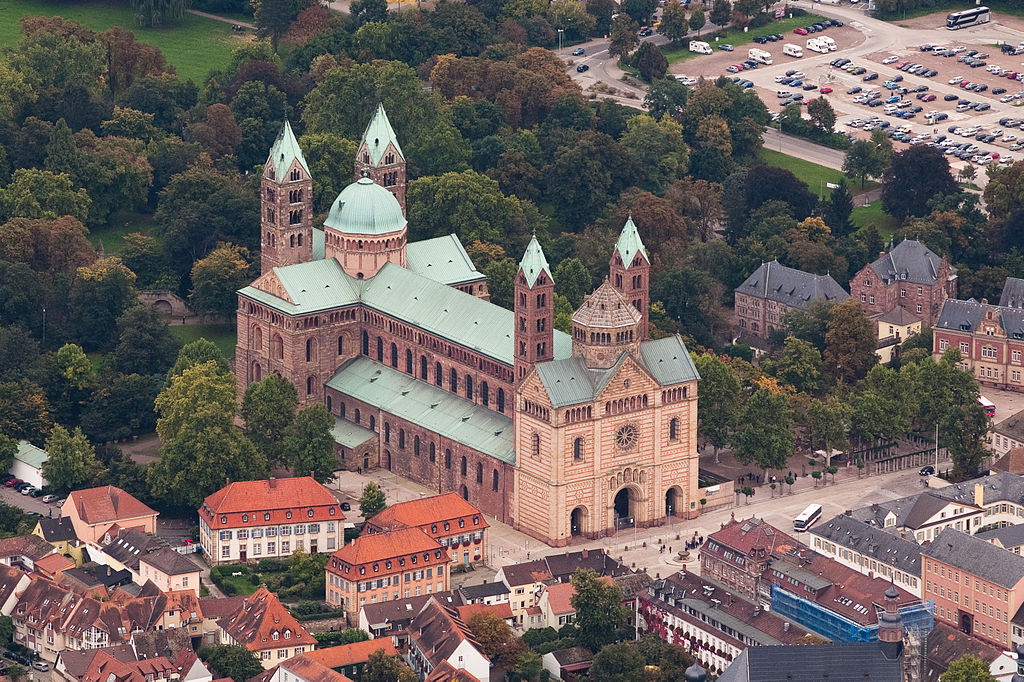
Speyer Cathedral is a Romanesque Cathedral located in southwestern Deutschland. Construction on the cathedral began in 1030, and the exterior is built with a distinct cherry sandstone. Most of the church is from the later stages of the Romanesque age, but the Narthex and the front facade of the were both added in the 19th century. The work was done in a Neo-Romanesque fashion, which gives the church building a pretty cohesive advent.

The interior of the Speyer Cathedral features one of the tallest naves from the Romanesque Age. The church likewise features a Butt Vault, which was an important innovation in Romanesque Architecture, which evolved into the Gothic Ribbed Vault. Speyer Cathedral and the city of Speyer itself were both repeatedly involved in the conflict of the 30 Years' War, merely despite these turbulent times, the church is nevertheless remarkably preserved considering its incredible historic period.
Like Compages of Cities? Sign up for our mailing listing to get updates on our latest articles and other data related to Architectural History.
5. Basilica of Saint-Sernin – Toulouse, Occitanie, France
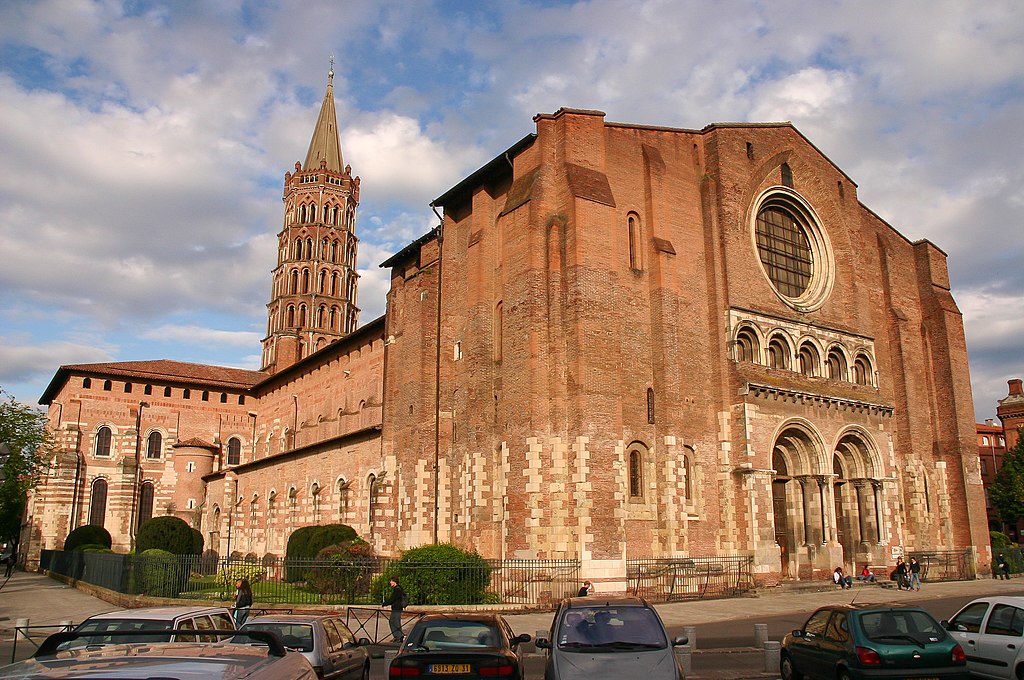
While Speyer Cathedral in Frg may be the largest Romanesque cathedral in the world, the championship of the largest Romanesque building in the world goes to the Basilica of Saint-Sernin in France. The church building was constructed from 1080-1120 and was originally part of a much larger abbey. The interior features a vaulted roof made of stone, which was a huge technological achievement over the apartment wooden ceilings y'all will find on many other Romanesque buildings. Additionally, the stone vault was a huge leap forward in fire protection.
half dozen. Trier Cathedral – Trier, Rhineland-Palatinate, Germany
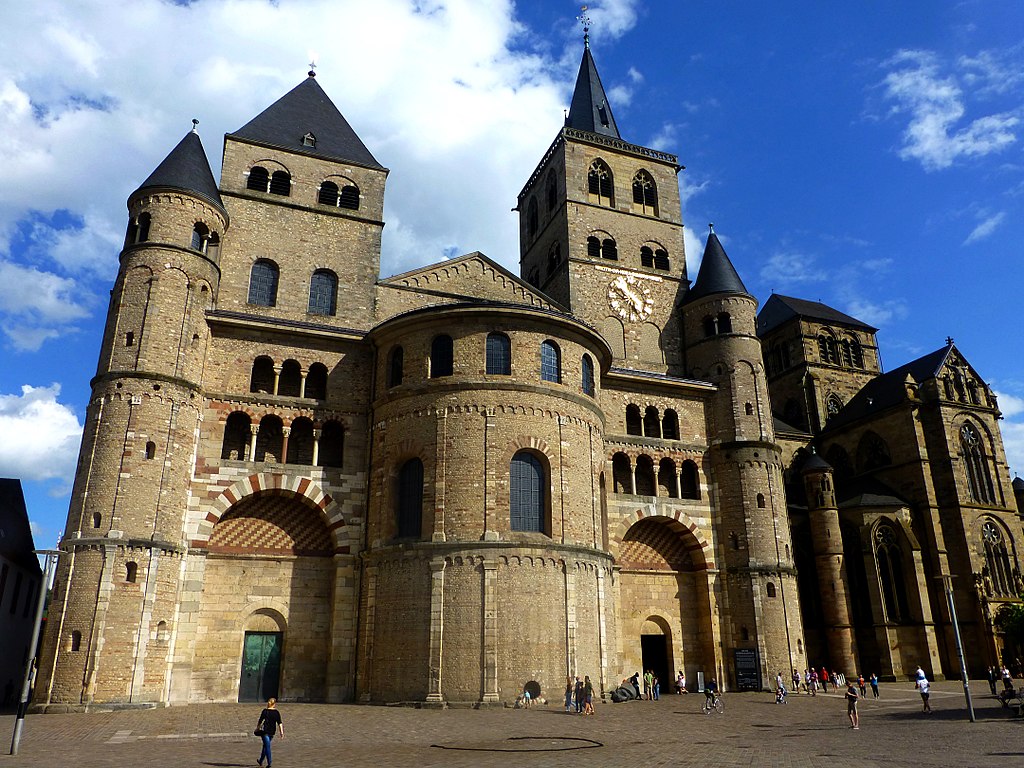
Trier Cathedral stands on the foundation of several Roman buildings that were congenital in the ivthursday century CE. The bulk of the church that is seen today dates from the 11thursday century from 1016-1041. The church is famous for its several towers which were oft replicated in other Romanesque buildings throughout Europe.
7. Maria Laach Abbey – Andernach, Rhineland-Palatinate, Germany
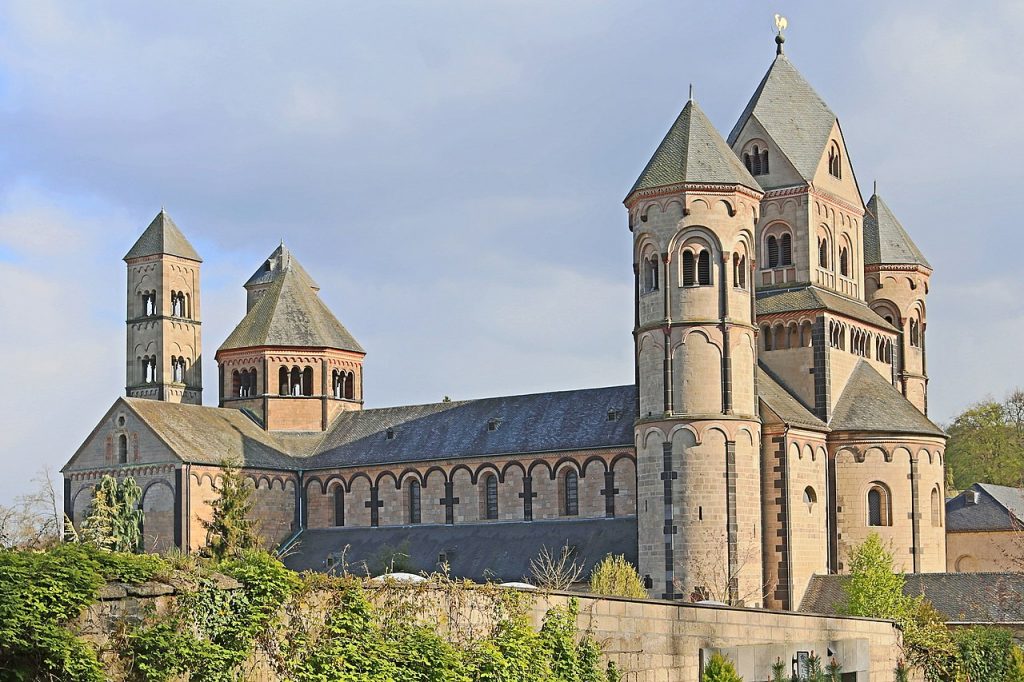
Abbeys and Monasteries were some of the wealthiest and near powerful establishments of the center ages. All of that wealth and power often resulted in fantastic compages. Maria Laach Abbey in Federal republic of germany is one of the virtually cohesive examples of Romanesque Architecture in Europe. The exterior is specially void of other building styles, unlike other churches on this list.
8. Ca' Loredan and Ca' Farsetti – Venice, Veneto, Italy
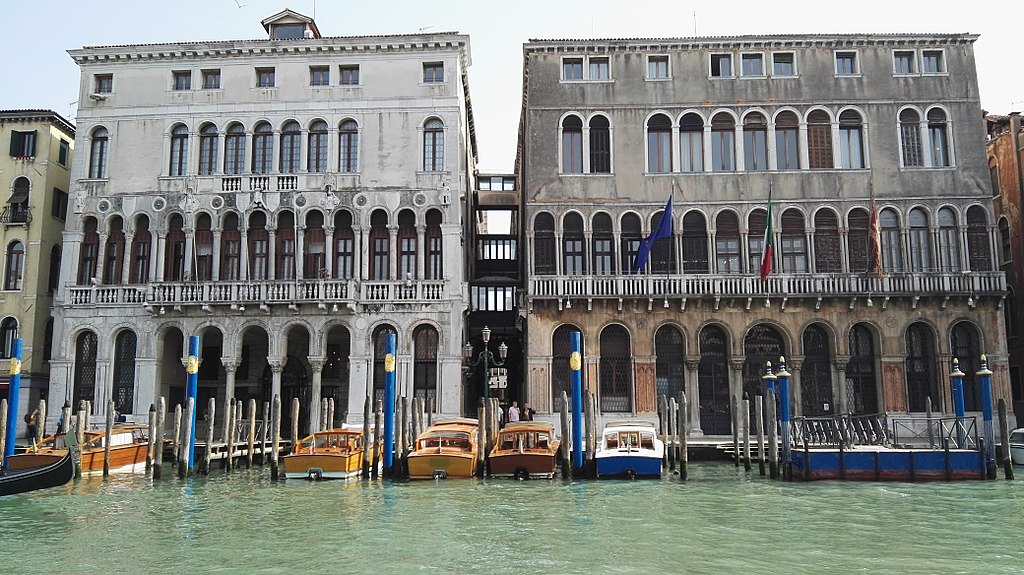
During the chaos and instability that followed the plummet of the Roman Empire, a group of refugees began a small settlement in the Venetian Lagoon. By the early on centre ages, their settlement grew into 1 of the most powerful cities in all of Europe, Venice. Venice was the capital of the mighty Republic of Venice, a maritime democracy that controlled nearly of the trade in the Adriatic and Mediterranean Seas. The Ca' Loredan and Ca' Farsetti, are two incredible works of Romanesque architecture that were financed past this impressive trade network. They are located right next to i some other overlooking the G Canal in Venice.
9. Church building of the Holy Sepulchre – Jerusalem, Jerusalem, Israel
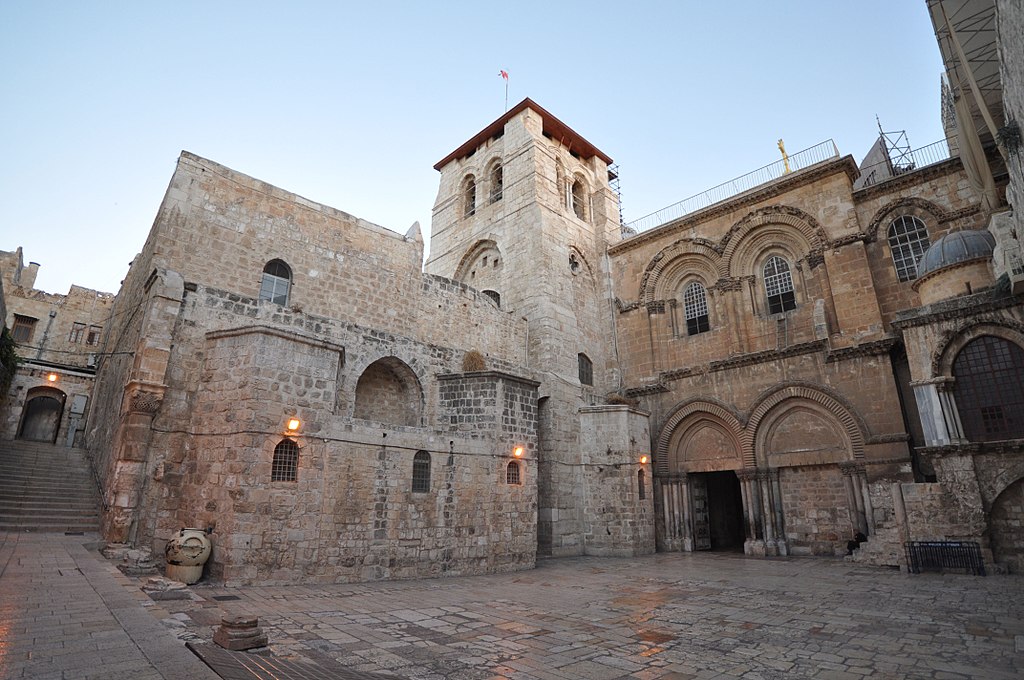
The Church of the Holy Sepulchre has a long and complicated history, stretching from the time of the Roman Empire all the mode until today. Much of the church is congenital in a singled-out Romanesque Fashion and dates from the 12th-thirteenth century. The Crusaders, who took the city of Jerusalem in the twelvemonth 1099, renovated and added to the church giving information technology its singled-out Romanesque appearance.
10. Lund Cathedral – Lund, Scania, Sweden
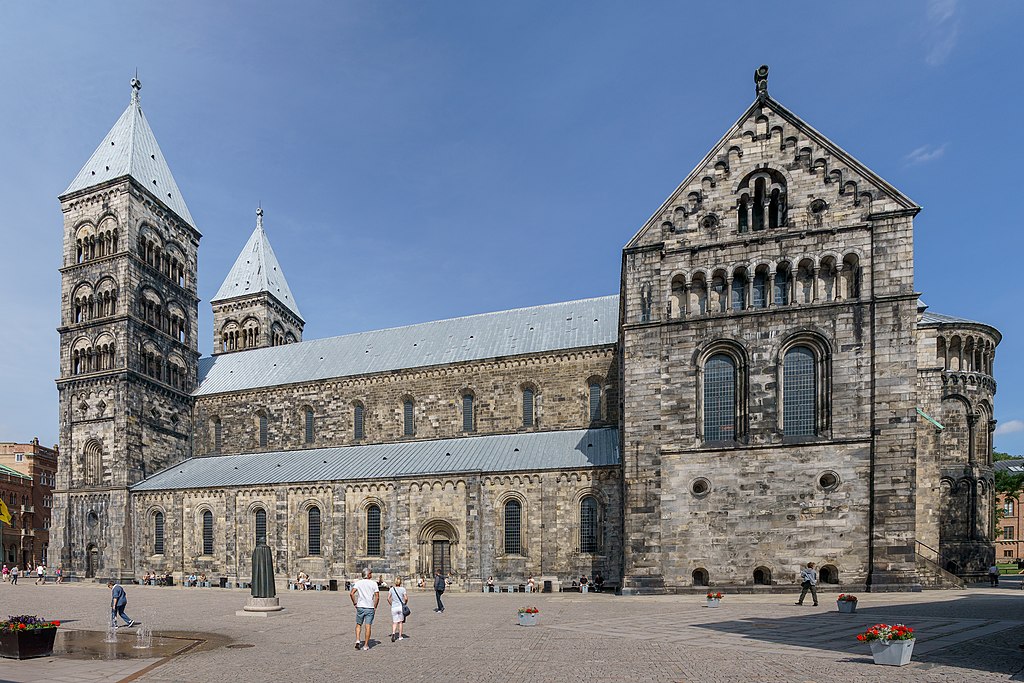
Lund Cathedral is the only Romanesque building on this list located in Scandinavia. The church was built in the early on 12th century and remains one of the oldest stone buildings in all of Sweden. At the time it was built, Lund was ruled by Denmark and then information technology can technically exist seen every bit a work of Danish Romanesque Architecture.
Interested in the Romanesque Architectural Style? Check out some of our related articles!
11. Cefalù Cathedral – Cefalù, Sicily, Italia
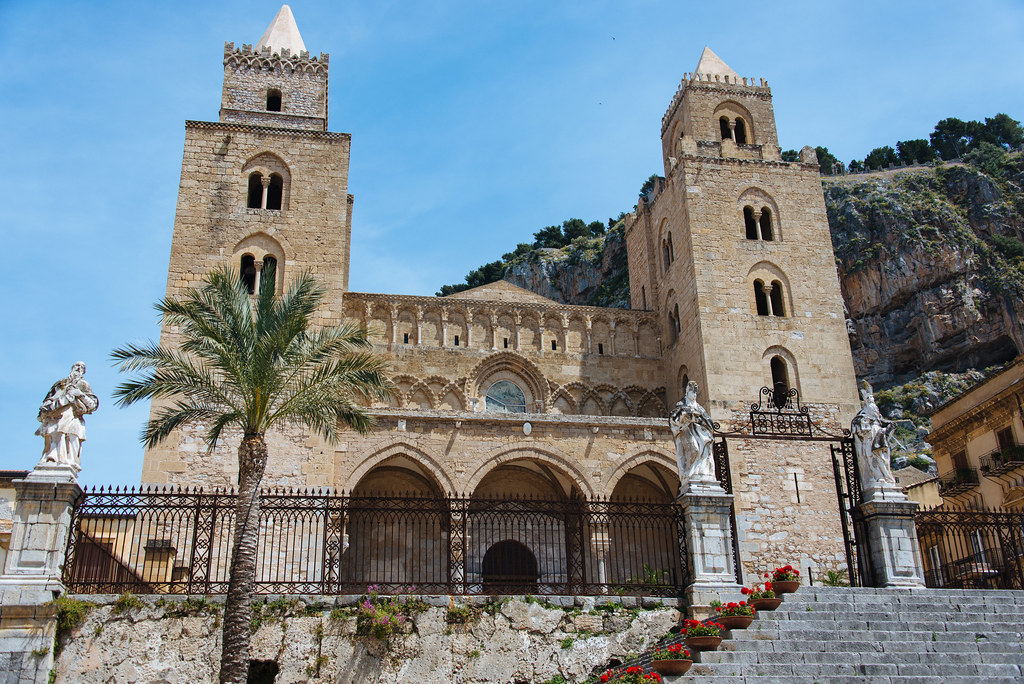
The Normans, which besides controlled parts of modern-day French republic and England, conquered Sicily and southern Italia in the early on middle ages. They created important works of Norman compages in that location, which is a subcategory within Romanesque architecture. Not just was the church congenital every bit a place of worship, but the architects also designed information technology equally a fortification to assist defend the town from invaders. Today, Cefalù Cathedral is the virtually notable landmark in the city of Cefalù and is listed equally a UNESCO World Heritage Site.
12. Parma Cathedral – Parma, Emilia-Romagna, Italia

Some other incredible Romanesque church is Parma Cathedral in Italy. Begun in 1059, the cathedral contains a divide baptistery, church, and bell tower. This was a similar design to many other churches in Italia. The baptisteries, in particular, were kept separate because no one was immune to enter the church building until after their baptism.
13. Vézelay Abbey – Vézelay, Burgundy, France
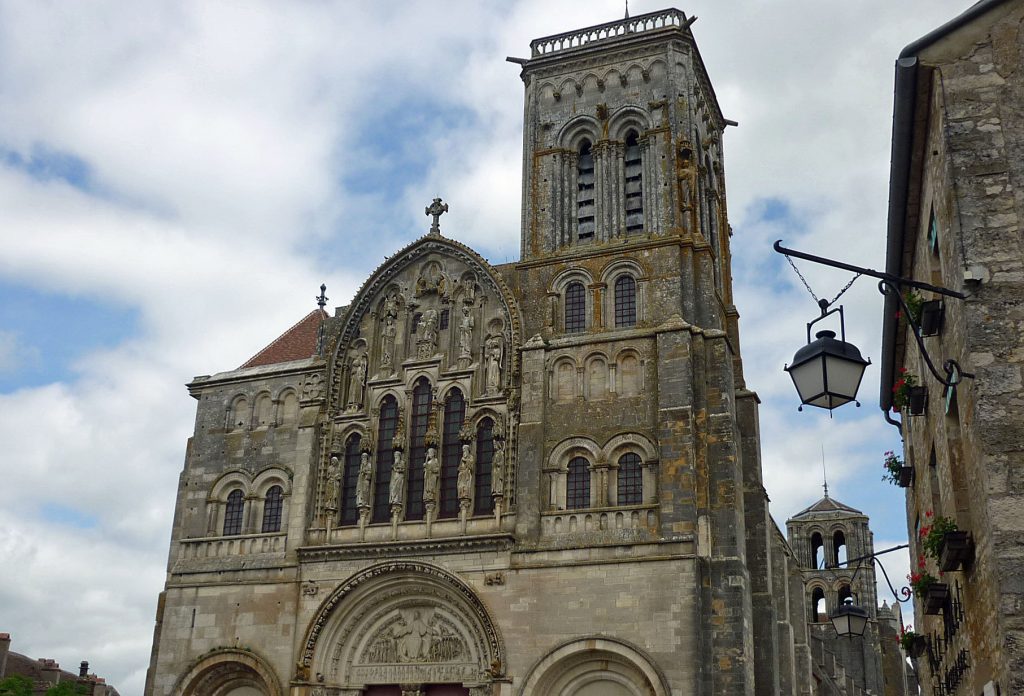
The Vézelay Abbey was constructed over a 30 year period from 1120 to 1150. I of the more ornamental churches on this list, the front elevation features multiple rock statues and sculptures. Traditionally, Romanesque buildings only had sculptures in the portal of the church building. (the part directly over the chief archway, also known equally the Tympanum) But Vézelay Abbey is known for having additional details throughout.
1iv. Aachen Cathedral – Aachen, North Rhine-Westphalia, Deutschland
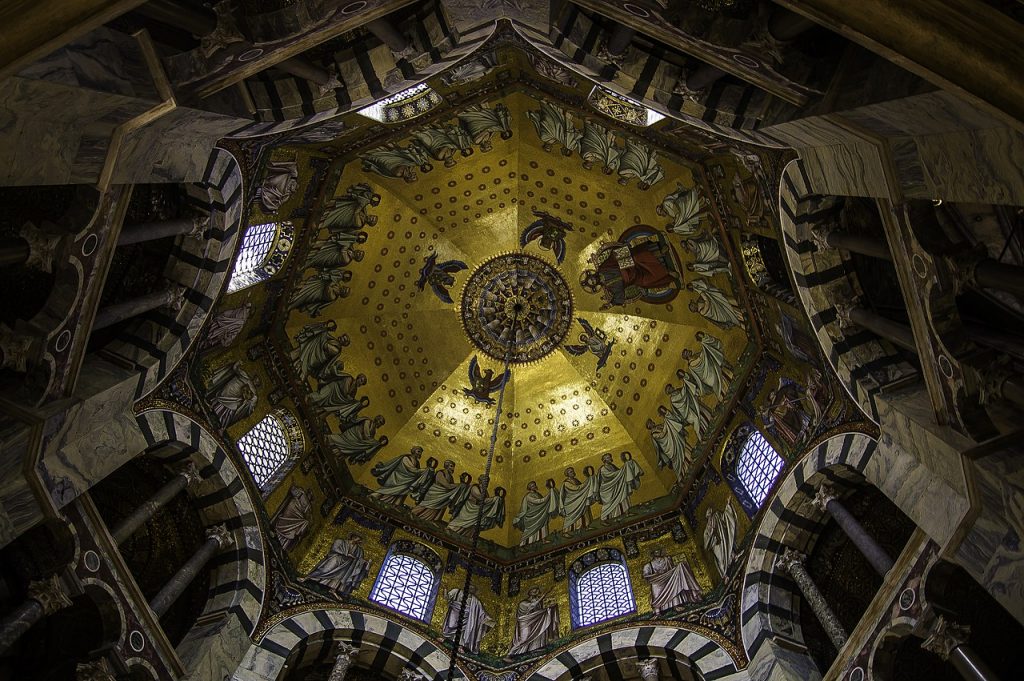
Aachen Cathedral is 1 of the greatest Romanesque Cathedrals on this listing. The building was built by the great Charlemagne. Charlemagne is regarded every bit the near influential ruler of the early on eye ages. He was able to create a massive empire that stretched through modern-day France, Germany, and Italia. Charlemagne often ruled from Aachen and was responsible for a large portion of Aachen Cathedral.
ane5. Tower of London – London, England, Uk

William the conquistador was the Knuckles of Normandy during the early 11th century. He gained his nickname after he crossed the English language Aqueduct and defeated the previous ruler of England to become the first Norman King of England. To aid maintain control of his new kingdom, William began construction on the Tower of London. Overlooking the Thames River in London, the edifice is a not bad example of a Romanesque style fortification.
Romanesque Architecture Today
Although not as popular as it was at the stop of the 19th century, Romanesque Architecture yet lives on today in the form of the Neo-Romanesque style. A great example of a Neo-Romanesque edifice is the Fisherman's Bastion located in Budapest, Hungary.

Photo by Nikolai Karaneschev from Wikimedia Commons
During the early on 19th century, the Neo-Classical manner became extremely popular. It was utilized past several world powers to construct important authorities buildings that recalled the ability and strength of the Ancient Roman government system.
Ironically, just as Romanesque architecture evolved from the architecture of the Roman Empire, Neo-Romanesque became quite popular in the aftermath of the golden age of Neo-Classical architecture.
Richardsonian Romanesque
Richardsonian Romanesque is a term coined to describe the distinct Neo-Romanesque buildings of HH Richardson and other American Architects in the late 19th century. Some of the most notable works are Trinity Church in Boston likewise as the Winn Memorial Library in Woburn Massachusetts.
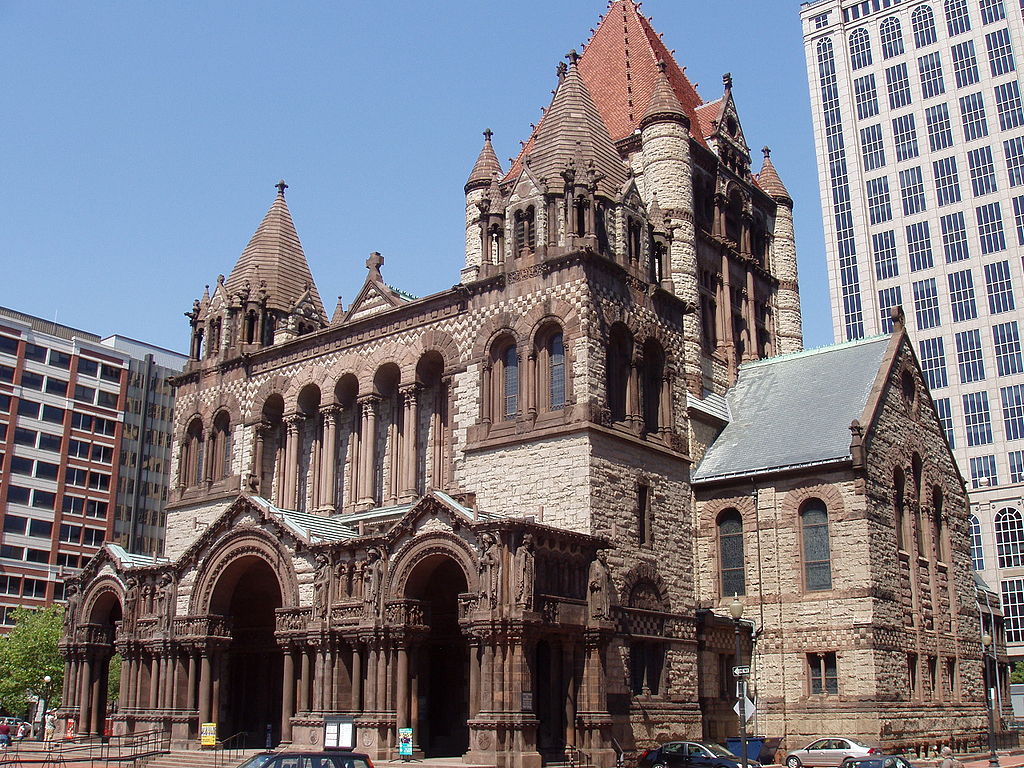
Photo by Daderot from Wikimedia Commons
Although much different thanks to new technologies in masonry construction, Richardsonian Romanesque utilizes many of the distinct principles of Romanesque compages. The heavy and beefy forms, paired with the rounded arches greatly resemble the Romanesque buildings that were pop in Europe during the center ages.
Romanesque Architecture's Legacy
Architecture as a whole was greatly influenced by the Romanesque style. Romanesque architecture represents a articulate link to the architecture of the Roman Empire and Gothic Compages.
And then many of Europe's greatest cathedrals were built in the Gothic manner, and all of the innovations that made those buildings possible were learned during the Romanesque menstruum.
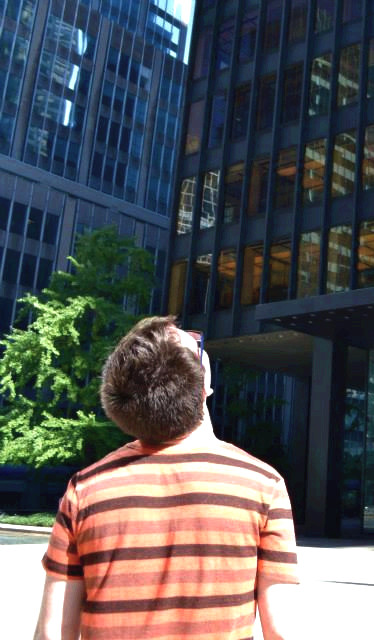
- About the Writer
- Rob Carney, the founder and lead writer for Architecture of Cities has been studying the history of architecture for over 15 years.
- He is an gorging traveler and photographer, and he is passionate about buildings and building history.
- Rob has a B.S. and a Master's caste in Compages and has worked as an builder and engineer in the Boston area for 10 years.
Like Architecture of Cities? Sign up for our mailing list to go updates on our latest articles and other information related to Architectural History.
How can you help Architecture of Cities?
- If yous are interested in helping grow and improve Architecture of Cities, you lot tin back up us on Patreon!
- Becoming a Patreon Supporter gets you lot early access to new articles – and everything we earn goes back into generating new content, improving our existing articles, and helping u.s. create the best user experience for our readers.
- Special thanks to all of our electric current Patreon Supporters!

freemanthrealthen.blogspot.com
Source: https://architectureofcities.com/romanesque-architecture
0 Response to "What Did Ancient Architects and Builders Use in the Construction of Classical Cathedrals Art"
Post a Comment